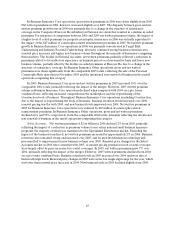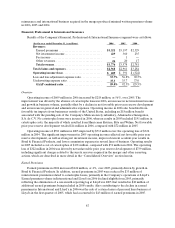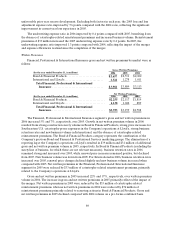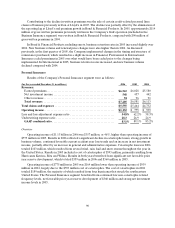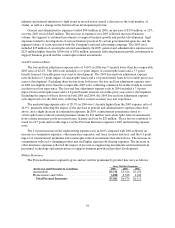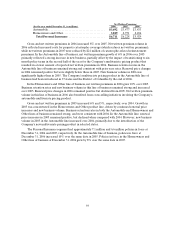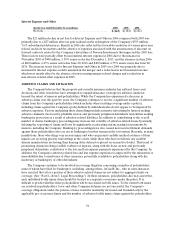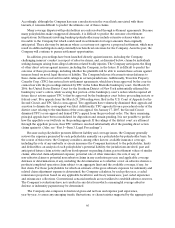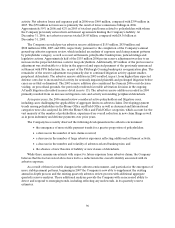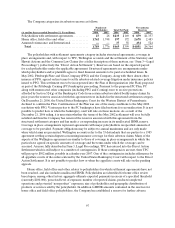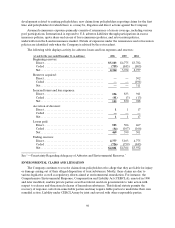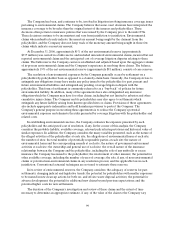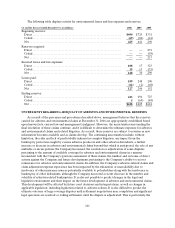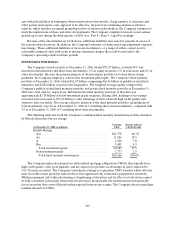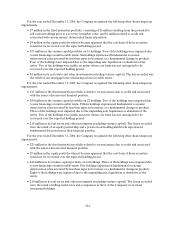Travelers 2006 Annual Report Download - page 107
Download and view the complete annual report
Please find page 107 of the 2006 Travelers annual report below. You can navigate through the pages in the report by either clicking on the pages listed below, or by using the keyword search tool below to find specific information within the annual report.95
Accordingly, although the Company has seen a moderationin the overall risk associated with these
lawsuits, it remains difficult to predict the ultimate cost of these claims.
Many coverage disputes with policyholders are only resolved through settlement agreements. Because
many policyholders make exaggerated demands, it is difficult to predict the outcome of settlement
negotiations. Settlements involving bankrupt policyholders may include extensive releases which are
favorable to the Company butwhich could result in settlements for larger amounts than originally
anticipated. There also may be instances where a court may not approve a proposed settlement, which may
result in additional litigation and potentially less beneficial outcomes for the Company. As in the past, the
Company will continue to pursue settlement opportunities.
In addition, proceedings have been launched directly against insurers, including the Company,
challenging insurers’ conduct in respect of asbestos claims, and, as discussed below, claims by individuals
seeking damages arising from alleged asbestos-relatedbodily injuries. The Company anticipates the filing
of other direct actions against insurers, including the Company, in the future. It is difficult to predict the
outcome of these proceedings, including whether the plaintiffs will be able to sustain these actions against
insurers based on novel legal theories of liability. The Company believes it has meritorious defenses to
these claims and has received favorable rulings in certain jurisdictions. Additionally, Travelers Property
Casualty Corp. (TPC) has entered into settlement agreements, which have been approved by the court in
connection with the proceedings initiated by TPC in the Johns Manville bankruptcy court. On March 29,
2006, the United States District Court for the Southern District of New York substantially affirmed the
bankruptcy court’s orders, while vacating that portion of the bankruptcy court’s orders which required all
future direct actions against TPC to first be approved by the bankruptcy court before proceeding in state or
federal court. Five appeals fromthe March29, 2006 ruling were filed in the U.S. Court of Appeals for the
Second Circuit, and TPC filed a cross-appeal. Two appellants have voluntarily dismissed their appeals and
a motion to dismiss the cross-appeal was filed. Additionally, TPC appealed from a procedural order of the
district court relating to the timeliness of the cross-appeal. On January 17, 2007, the Second Circuit
dismissed TPC’s cross-appeal and denied TPC’s appeal from the procedural order. The three remaining
principal appeals have been consolidated for disposition and remain pending. It is not possible to predict
how the appellate court will rule on the pending appeals. If the rulings of the district court are affirmed
through the appellate process, then TPC will have resolved substantially all of the pending direct action
claims against it. (Also, see “Part I—Item 3, Legal Proceedings”).
Because each policyholder presents different liability and coverage issues, the Company generally
reviews the exposure presented by eachpolicyholder annually on a policyholder-by-policyholder basis. In
the course of this review, the Company considers, among other factors: available insurance coverage,
including the role of any umbrella or excess insurance the Company has issued to the policyholder; limits
and deductibles; an analysis of each policyholder’s potential liability; the jurisdictions involved; past and
anticipated future claim activity and loss development on pending claims; past settlement values of similar
claims; allocated claim adjustment expense; potential role of other insurance; the role, if any, of
non-asbestos claims or potential non-asbestos claims in any resolution process;and applicable coverage
defenses or determinations, if any, including thedetermination as to whether or not an asbestos claim is a
products/completed operation claim subject to an aggregate limit and the available coverage, if any, for
that claim. For those policyholders for which an estimate of the gross ultimate exposure for indemnity and
related claim adjustment expense is determined, the Company calculates, by eachpolicy year, a ceded
reinsurance projection based on any applicable facultative and treaty reinsurance, past ceded experience
and reinsurance collections. Conventional actuarial methods are not utilized to establish asbestos reserves.
The Company’s evaluations have not resulted in anydata from which a meaningful average asbestos
defense or indemnity payment may bedetermined.
The Company also compares its historical gross and net loss and expensepaidexperience,
year-by-year, to assess any emerging trends, fluctuations, or characteristics suggested by the aggregate paid


